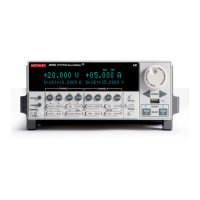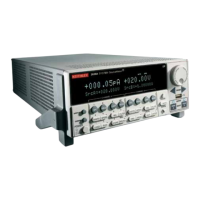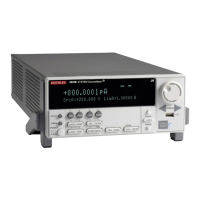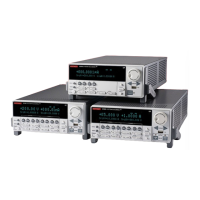12-2 Return to Section Topics 2600S-901-01 Rev. C / January 2008
Section 12: Instrument Control Library Series 2600 System SourceMeter® Instruments Reference Manual
Command programming notes
Conventions
For the following command reference, it is necessary to understand the following conventions:
Wild characters
Many Source-measure-unit (SMU) commands are expressed in a generic form using wild
characters. A wild character indicates a SMU channel, function or trigger line. Keep in mind that
wild characters used in the generic form are NOT to be included in the command sent to the
instrument.
X and Y
The X character is used for functions and attributes to indicate the SMU channel (a or b) and Y is
used to indicate the SMU function (
v, i, r or p). For example, the attribute for the source output
setting is generically expressed as follows:
smuX.source.levelY
To program SMU channel A to 5 volts, the following command statement is to be sent to the
instrument:
smua.source.levelv = 5.0
To program SMU channel B to 1 milliampere, the following command statement is to be sent to the
instrument:
smub.source.leveli = 0.001
NOTE The wild characters X and/or Y are NEVER sent to the instrument.
They are used in this command reference for notational convenience
only.
[N]
The N character, enclosed by brackets ([ ]), is used in functions and attributes for the Digital I/O
line (
1 to 14). For example, the function to assert an output trigger is generically expressed as
follows:
digio.trigger[N].assert
To program the Series 2600 to assert an output trigger on trigger line 5, the following command
statement is sent to the instrument.
digio.trigger[5].assert()
NOTE The wild character N should NOT to be sent to the instrument.
However, the brackets (
[ ]) must be included in the command. Also,
note that the above command requires that a set of open and closed
parenthesis (
()) be appended to the function (see “Functions” in
following subsection).
